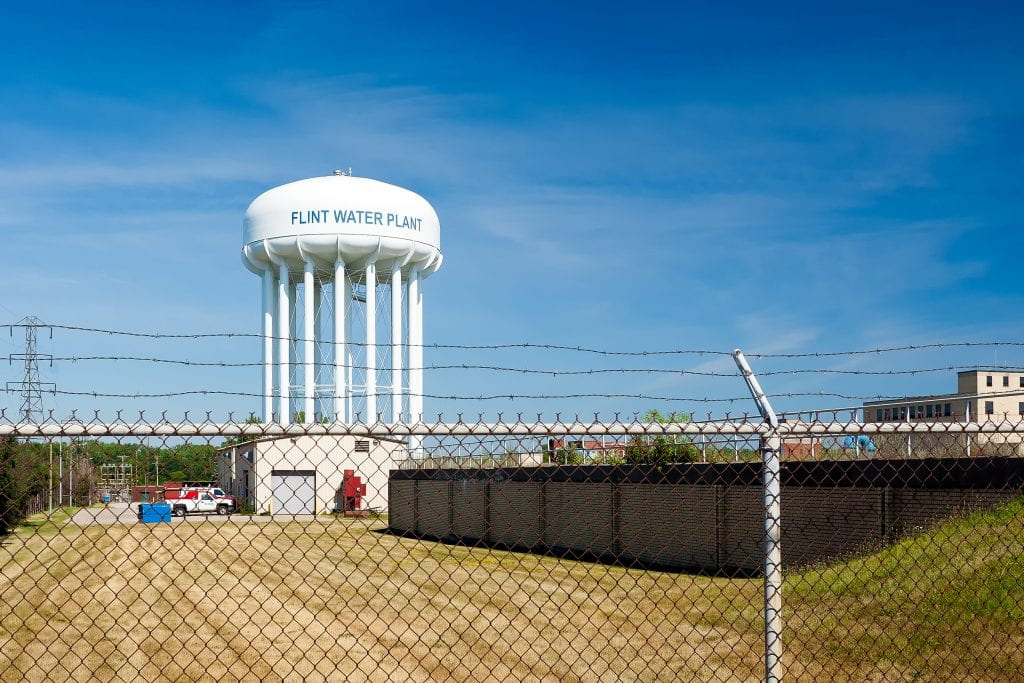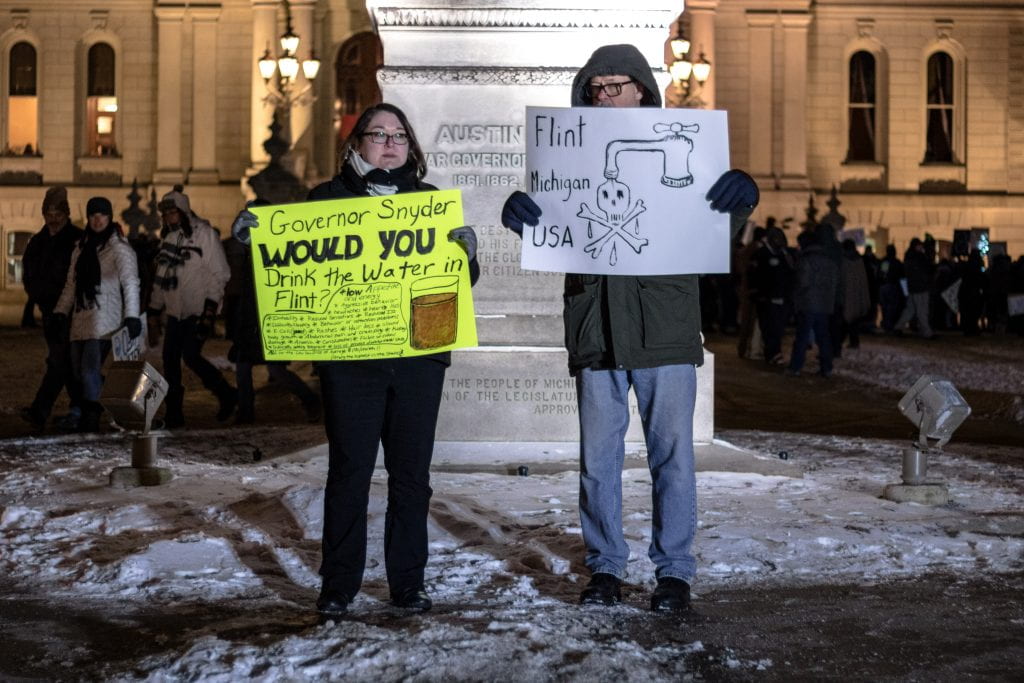
“Nothing that has been uncovered to date suggests that anyone intended to poison the people of Flint” (Michigan Civil Rights Commission, 2017). The Flint Water Crisis: Systemic Racism Through the Lens of Flint report was authored in response to the growing cries from community members, government officials, victims, and bystanders concerned with the abject lack of proper response to Flint water crisis which began roughly at the middle of 2014. The Flint Water Crisis, nationally and internationally infamous for the beleaguered and dangerous handling by all levels of government, has been documented, historicized, lectured upon, and dissected from news publishers, academics institutions, watchdog groups, government organizations, and everyone in between. The bottom line is government officials cut costs in water sanitation and pipe replacements, the consequences of which sparked a full-blown state of emergency, and finally culminated in the deaths of Flint citizens from Legionnaire’s disease and other complications from the consumption of unclean water; those implicated range from District Water Supervisor Busch to Michigan Governor Rick Snyder. The failings in Flint, as argued by the Michigan Civil Rights Commission, extend far beyond the ineptitude of handfuls of government officials and their lack of planning or preparedness. The requisite conditions necessary for a crisis of this magnitude festered many years ago, perhaps as far back as the US Supreme Court’s ruling in Plessy v. Ferguson. Flint’s problems are institutional and systemic, and unfortunately, it took a catastrophe to bring these issues to the surface.
Structural racialization is understood as the tendency for social groups to “organize around structures that produce discriminatory results… without themselves possessing any personal animus” (Michigan Civil Rights Commission, 2017). In other words, an individual can actively contribute to community systems that result in suppression without actually harboring ill will to the victims of suppression themselves. Ignorance/implicit bias, according to john a. powell (2010), is the primary driver behind structural racialization and its horrifying consequences. Implicit bias–directly linked to structural racialization–sustains the longevity of the structures which cause discrimination, and these structures are kept alive only if the contributors to the structures are unaware of the malevolent consequences of the structures themselves (powell, 2010). In the case of Flint, structural racialization began many years before the water crisis, and these implicit, racial structures ensured destruction from the crisis unfairly affected largely black, poor, politically unconnected individuals in the Flint area (Michigan Civil Rights Commission, 2017). Using the term ‘structural racialization’ to describe a public health catastrophe, such as the Flint Water Crisis, offers no binding legal or moral prescription. There is no way to sue a ‘structure’ for unfair or discriminatory harm. The structure, in these cases, is reciprocally determined by every individual who unknowingly benefits from the structure and does not actively fight against the structure’s survival (powell, 2010). The case of Flint is rife with example. Contribution to underlying power structures such as these begins with implicit bias- it is the first stronghold keeping the structure in place. Implicit bias, by definition, is unseen and unfelt. In this case, the denizens of Flint and the surrounding areas had no awareness of their complicity in structural racialization. Without this awareness, there can be no hope to fight it.
Beyond the psychology of the issue is the legalistic support of structural racialization. In Flint, this involves segregated housing. The 1900-1930s saw a time of deeply-seated racist and discriminatory housing market practices that forcibly shepherded blacks and poorer whites into select neighborhoods in Flint. These were effectively ‘ghettos’ and ensured black renters and homeowners were segregated from whites (Michigan Civil Rights Commission, 2017). Fast forward to present day: the neighborhoods hit hardest by the Water Crisis are neighborhoods that historically have belonged to poor and black renters and homeowners. Racist business practices in the Jim Crow era exacerbated the loss and destruction felt by black and poor Flint citizens in the present day.

This is not to say the black community in Flint is the only one to feel the deleterious effects of the water crisis. This public health emergency does not discriminate along ethnic lines. The discriminatory practices that trapped black Flint citizens holds that honor alone. In 2017, a full three years after the crisis began, clean water is still an issue in Flint. What do we tell the citizens of Flint? How can they take civic action to expedite the process of returning to ‘normal’ life post-crisis? Diana Francis, noted peacemaker and democracy advocate, espouses the concept of ‘speaking truth to power’. This notion contends people–everyday concerned citizens–are the impetus of action in situational injustice. Indeed, the recent criminal charges brought against Flint city administrators and politicians show a ‘top-down’ approach to this crisis is both unrealistic and ineffective. For Francis, the true heroes in this story are citizens affected by and emphatic to the crisis. Examining the normative response to Flint reveals a public willing to undertake protest and direct action, and a public expecting a direct confrontation with the individuals and systemic structures responsible for this crisis. Here are some examples: a music festival raising awareness and money for the victims of Flint, national groups donating time and energy to provide resources to disenfranchised Fint citizens, whistleblowers risking their livlihoods to make the crisis public, and academics donating their skills to investigating the crisis itself. These civil society actors may hold the key to eliminating the effects of the Flint water crisis and eradicating the conditions that precipitated the crisis in the first place. Of course, this empowered response is not an assumed reaction.
In the face of a fully-fledged public health emergency, many citizens in Flint did not feel any semblance of trust in their elected officials to mitigate the crisis without state- or national-level intervention. Without this trust, the citizens may have felt unable or ineffective to act against the discriminatory power structures in Flint. This problem, unlike replacing pipes, cannot be ameliorated by federal funding or outside medical intervention. Addressing this collective distrust will involve some form of cultural transformation. These deeper fixes must involve the access to elected officials the general public has and the public’s ability to provide continuous feedback to these officials. At several times in the Michigan Civil Rights Commission (2017), citizens of Flint (of all ethnicities) went on the record saying their concerns regarding water safety went unaddressed due to many factors, such as:
1) no knowledge of how to reach elected officials,
2) feeling their complaints were ‘unheard’ or ‘unseen’ to those who could help the situation,
3) fear of retaliation if undocumented immigrants or individuals with criminal records came forward with concerns, and
4) willful neglect on the part of government officials who simply did not feel accountable for the plights of minorities (involving both ethnicity and socioeconomic status) in the Flint area.

Moving forward, how can both human rights advocates and ordinary citizens protect rights equally in all corners of the globe and also address the grievances of individuals in Flint? A shift towards environmental justice may be the answer. This term means two things. First, all persons, regardless of identifying characteristics (ethnicity, gender identity, sexual orientation, income level, etc.) have the right to enjoy the environment equally. Second, the responsibility of civic participation in the protection and maintenance of the environment belongs to all persons (Michigan Civil Rights Commission, 2017). Environmental justice takes its cue from Third Generation Human Rights (aka right to the environment) and adds the necessary ingredient of civic participation. As I have stated previously on this blog, human rights are protected by “people, not documents”. Given the second caveat of environmental justice, what happens if ordinary people have no avenue to address a public health hazard? A crisis like Flint erupts. What conditions predicate an inability to make these addresses? This post contends a key condition is structural racialization. Addressing the massive failures apparent in the Flint Water Crisis moves far beyond faulty equipment and the Flint city administration’s glacial response time. Addressing this egregious human rights violation requires analysis going back at least a century in order to fully understand the complex interaction between history and the present. Furthermore, the only long-term, stable solution to this issue is to equip the citizens of Flint with inexperienced political power and know-how. This may include any of the following: a free, fair, and frequent election process; a truly representative (i.e. ethnicity, socio-economic status) local administration; a political mechanism by which citizens can openly voice public health concerns; and funding available in case large-scale crises such as these emerge. Environmental justice in Flint, Michigan will only be achieved when the insidious structures barring unfettered access to a clean environment and free critique of those hindering this access are dismantled in their entirety.
Sources:
Powell, j. a. (2010). Structural racialization and the geography of opportunity. Online lecture. http://kirwaninstitute.osu.edu/wp-content/uploads/2011/02/2010_0611_tfn_sm_growth_training.pdf
Michigan Civil Rights Commission (2017). The Flint Water Crisis: Systemic Racism Through the Lens of Flint. https://www.michigan.gov/documents/mdcr/VFlintCrisisRep-F-Edited3-13-17_554317_7.pdf
